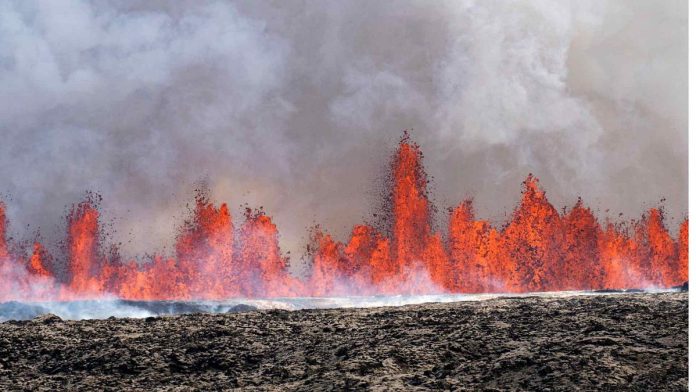Lava is spewing 50m into the air out of a 3.5km-long fissure.
A volcano in Iceland has erupted for the fifth time in three months.
Lava may be seen spilling from the Sundhnúkur crater row. It began within the early afternoon today, 29 May, and it’s ongoing.
Visitors have been evacuated from the Blue Lagoon thermal spa, one in every of Iceland’s top tourist attractions, and it stays closed.
The eruption site is a couple of kilometres northeast of Grindavik, a coastal town of three,800 people about 50 kilometres southwest of Iceland’s capital, Reykjavik. Grindavik has been evacuated and the roads around it are closed.
Despite lying just 20 km north of the eruption site, Keflavik International Airport – Iceland’s important international airport – stays open and flights are still arriving and departing. Nonetheless the airport advised passengers to “monitor flight information”.
If you happen to are planning on travelling to or from the affected area, listed below are the complete details on advice from European governments and airlines.
How long will Iceland’s volcano eruption last?
Iceland’s Meteorological Office says “Intense seismic activity is ongoing on the Sundhnúkur crater row.
A magma propagation is perhaps starting or has began, and a volcanic eruption could follow.”
The Met Office says lava is shooting about 50 metres into the sky from a fissure about 3.5 kilometres long.
The Grindavik community was previously evacuated in November following a series of earthquakes that opened large cracks within the earth between the town and Sýlingarfell, a small mountain to the north.
Before the recent eruptions, the Svartsengi volcanic system north of Grindavik had been dormant for around 780 years. The volcano is just a couple of kilometres west of Fagradalsfjall, which was dormant for six,000 years before flaring to life in March 2021.
Iceland’s volcano eruption ‘is just not a tourist attraction’
During a recent eruption, Icelandic authorities declared a state of emergency after a whole lot of small earthquakes shook the Reykjanes Peninsula – the island nation’s most populated region.
“This is just not a tourist attraction and you should watch it from an amazing distance,” Vidir Reynisson, head of Iceland’s Civil Protection and Emergency Management, told national broadcaster RUV.
Yet the spectacular natural phenomenon is difficult for people to withstand. “It’s just [like] something from a movie!” said Robert Donald Forrester III, a tourist from the US.
For local residents, the emotions were mixed. “The town involved might find yourself under the lava,” said Ael Kermarec, a French tour guide living in Iceland. “It’s amazing to see but, there’s type of a bittersweet feeling for the time being.”
Have flights to Iceland been cancelled?
Despite concerns over the impact the eruption may have on travel, nearby Keflavik Airport stays operational. Icelandic airport operator ISAVIA advises passengers to observe flight information here.
Volcanic eruptions can pose a serious hazard to air travel as ash released into the atmosphere could cause jet engines to fail, damage flight control systems and reduce visibility.
Nonetheless, the airport has said they were used to volcanic activity and well-prepared to cope with it with no need to shut the airport.
Iceland’s Civil Protection and Emergency Management say, “Iceland is not any stranger to volcanic activity and experiences a median volcanic event every five years.
Icelandic authorities and the general public are highly prepared for such events, and Iceland has one in every of the world’s only volcanic preparedness measures.
Iceland’s geoscientists possess vast experience in coping with volcanic activities.”
A significant eruption in Iceland in April 2010 caused widespread disruption to air travel between Europe and North America. The quarter of a billion cubic metres of volcanic ash it ejected into the air led to greater than 100,000 flights being cancelled over an eight-day period.
Though there had been fears of a repeat, Eyjafjallajokull volcano erupted under circumstances that contributed to the immense size of its ash cloud. A glacier on top of it caused meltwater to rapidly cool the lava, creating tiny particles which were launched into the air by the steam produced within the eruption. These were then carried on the wind towards Europe.
Up to now three years, three eruptions have taken place on the Reykjanes Peninsula with no impact on air travel.
The European Aviation Safety Agency (EASA) can also be higher prepared for a significant volcanic ash event.
“Within the event of an eruption and development of an ash cloud, the agency will work with other aviation actors to evaluate the impact for aviation and make recommendations accordingly,” a press release on the EASA’s website from November reads.
Is it protected to travel to Iceland?
Travellers are advised to keep away from Grindavik and respect local restrictions. Visit the Icelandic Met Office and Secure Travel Iceland for the newest advice.
Otherwise, Iceland is currently a protected destination.
Keflavik International Airport and the road to it’s unaffected and operating normally.
Countries haven’t issued a ‘no-go’ travel warning for Iceland meaning that airlines and holiday firms are operating as normal and travellers who cancel their bookings don’t have any automatic right to a refund.
During a previous eruption Jonathan Frankham, general manager of travel insurance company World Nomads, said: “For those concerned about travel insurance coverage, and whether cancelling a visit is best, we’d advise travellers to exercise common sense and travel properly,” says
“It’s vital to notice that policies purchased after the earthquakes and consequential volcanic eruption became a ‘known event’ are unlikely to be covered, but we recommend checking your policy wording for exact details.”
He advised tourists to contact their airline or travel provider for assistance and the newest information.
Is the Blue Lagoon open?
The Blue Lagoon geothermal spa – one in every of Iceland’s biggest tourist attractions – was evacuated when the volcanic eruption began.
The spa remains to be closed, in keeping with the official website, and can remain closed until 31 May.
It says: “As a consequence of a volcanic eruption that commenced in Sundhnúksgígar on May 29, we took the precautionary measure of evacuating and temporarily close all our operational units today.
Further updates and data shall be provided here as they change into available.”
Blue Lagoon management said that each one customers with bookings can be contacted, and anyone wishing to alter or cancel their booking can achieve this on the official website.
Unlock the world’s wonders with unforgettable journeys tailored just for you! Whether you crave sun-kissed beaches, thrilling adventures, or rich cultural escapes, your dream destination awaits. Enjoy seamless travel with expert tips, exclusive deals, and handpicked experiences that Turn Every Trip into a lifetime memory.










